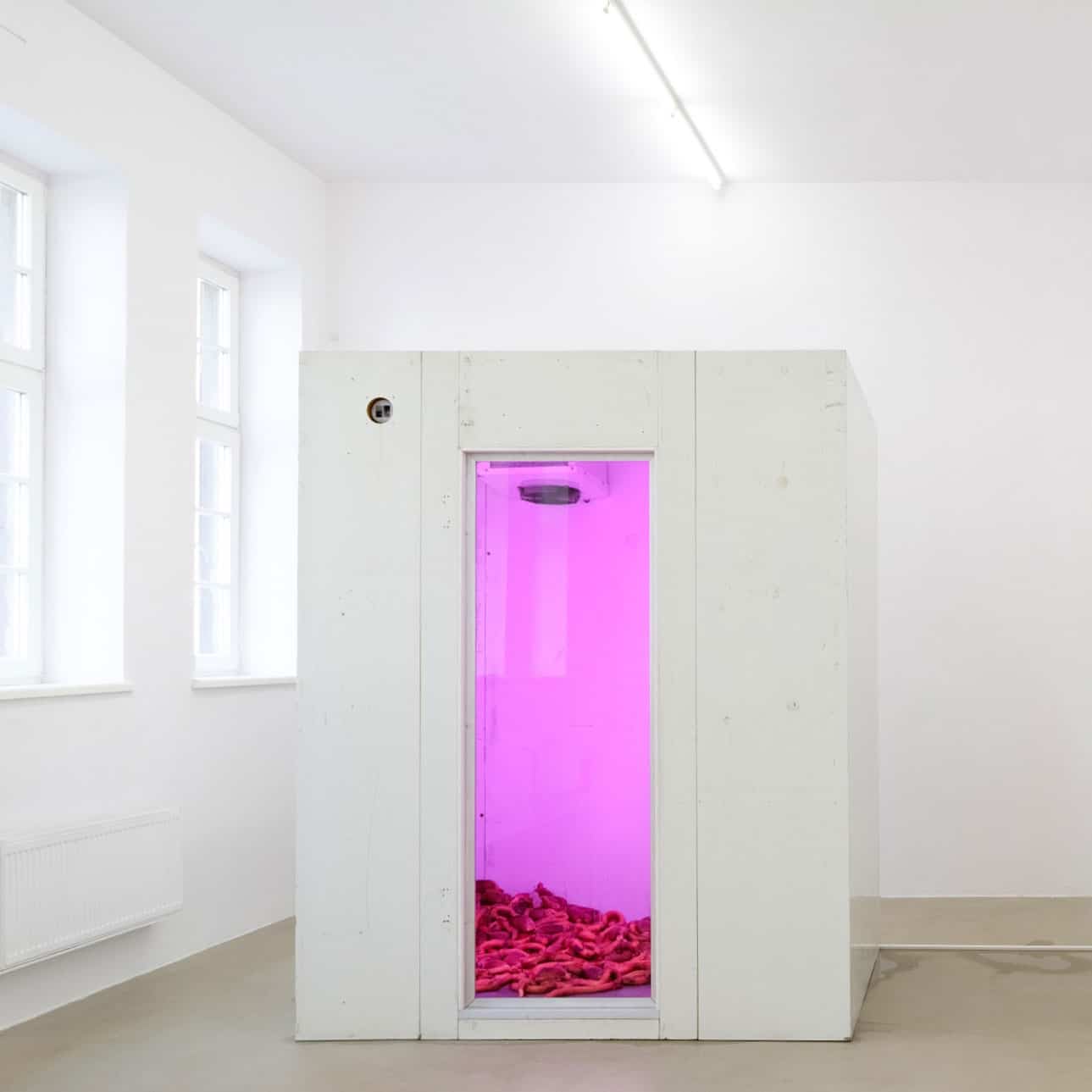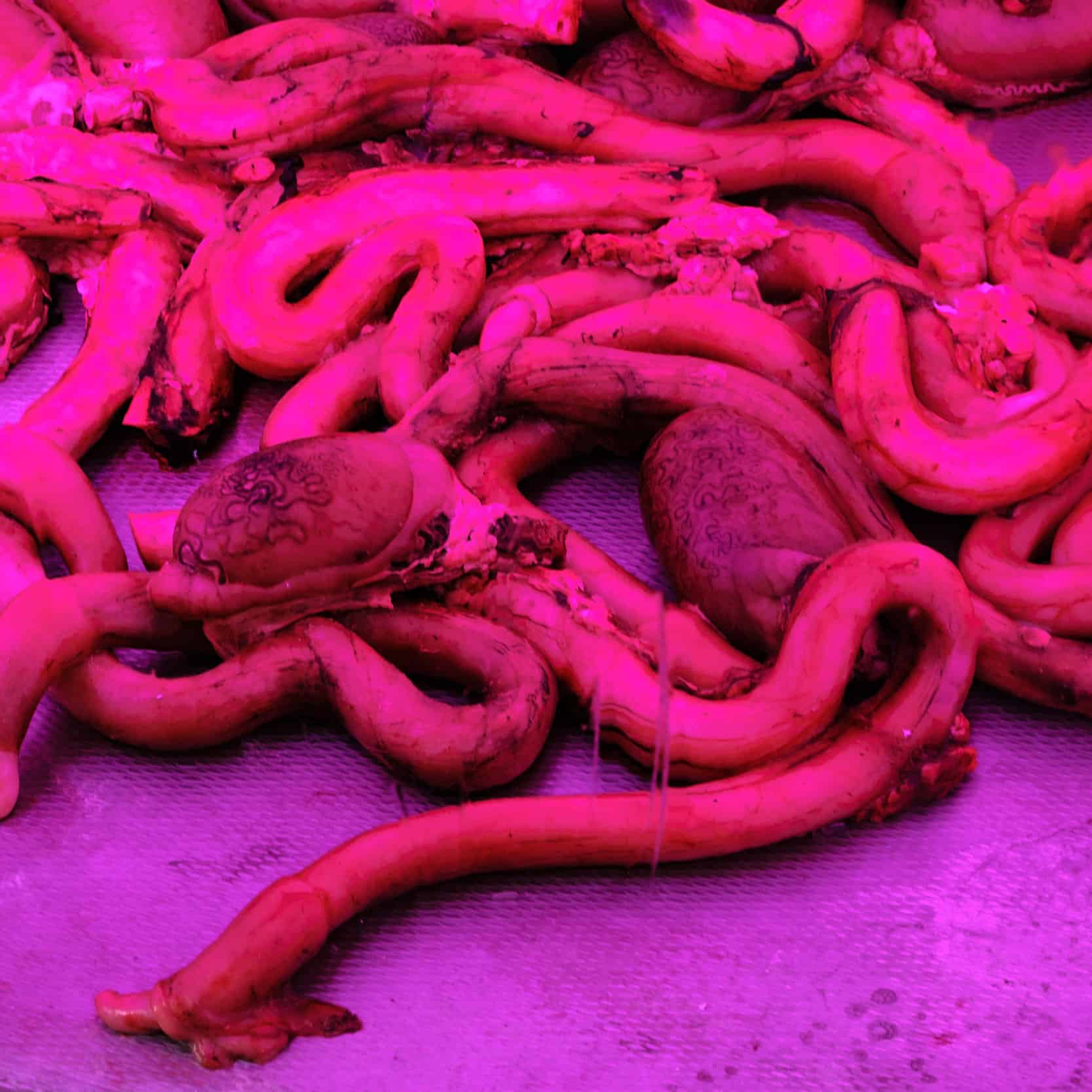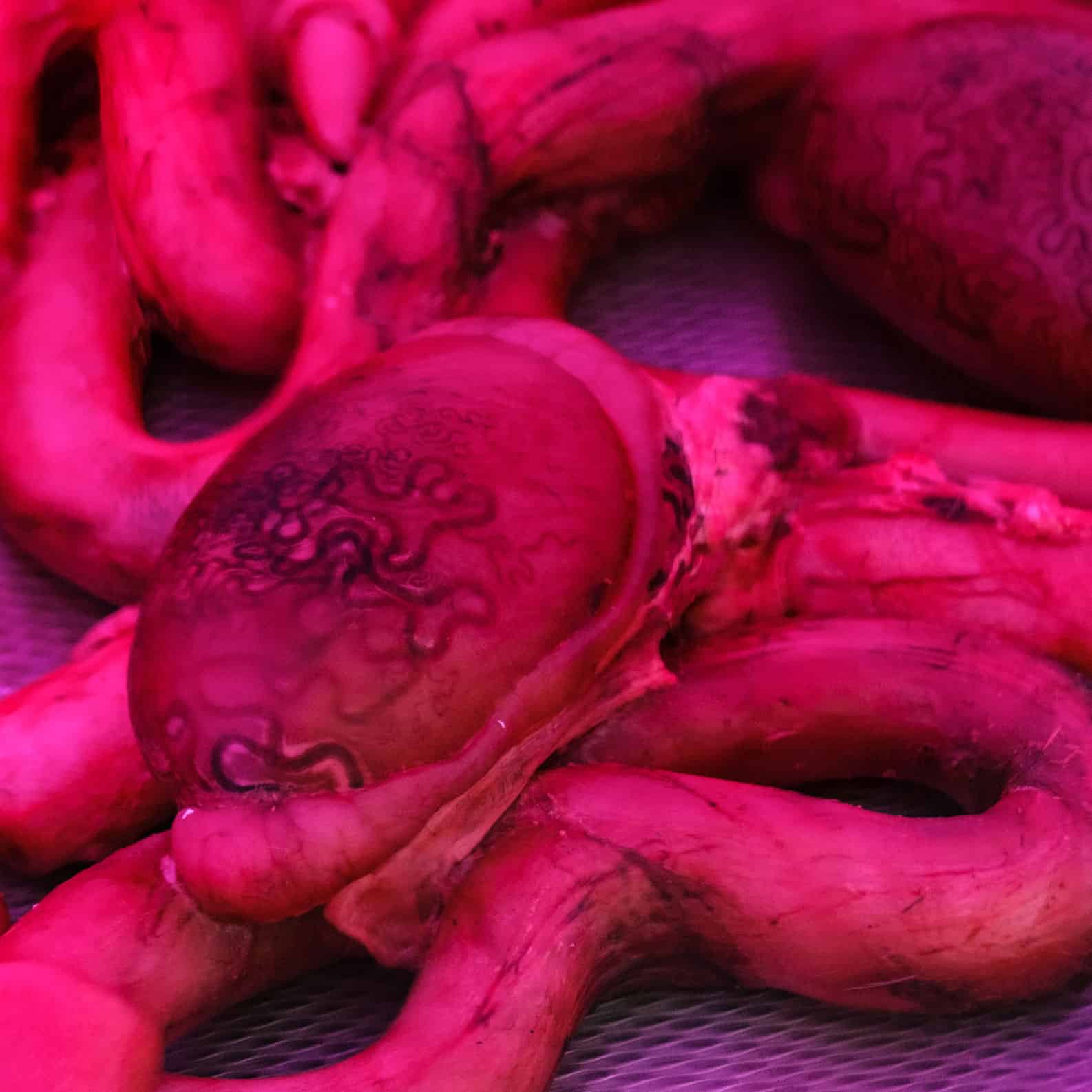What unites death and bliss? How and when do the borders between what’s animal and human blur? And does the consciousness foster or hinder one’s achievement of the state of bliss, in other words the eponymous jouissance – we discuss all these questions with Marek Wodzisławski, a graduate of painting and current PhD candidate at the Academy of Fine Arts in Kraków. His solo exhibition can be viewed until the end of August in the Gdańsk City Gallery at the Piwna Street.

Jouissance, Marek Wodzisławski fot.Bartosz Górka
Daga Ochendowska: Your exhibition is an award of the Gdańsk City Gallery in the Best Diplomas 2019 competition celebrating the best art graduates from Poland. Could you please tell our readers what have you prepared on this occasion?
Marek Wodzisławski: This year’s exhibition elaborates on the theme of relations between animals and human beings. My former piece Körperreise – displayed on the Best Diplomas Art Show – was the story of collision between body and technology, whereas this time around the body serves as the point of departure, not antithesis. The theme of a current exhibit is bliss which releases the animalistic potential. Animalism can be dangerous, obscene and thrilling. The idea was to reach into the depths of animal nature of humanity to bring out the interspecies space, recreate the common organic denominator between what’s human and non-human. Mutual consumption, satisfying one’s carnal needs with the bodies of others was my starting point. Here, consumption is the quintessence of bliss, as well as the lethal force, so meat along with the elements of deadly infrastructure, such as freezing chamber and slaughter apparatus, was juxtaposed against the lightbox referring to the cross-species sexual practices from mythology. The entire set design is codified in erotic pink. The second part of the exhibition is the projection documenting random locations of one-time stands.
DO: The animal theme runs through two components of the exhibit: bull penises in the freezer and the motif of Leda and the swan. However, you place these side by side with the footage of people captured by huntercams. Would you say that the acts they perform on camera belong to the animal or human sphere?
MW: The animal is the main axis of an exhibit. It manifests itself in the physical form, as taurine genitals and slaughter house waste, i.e. results of mass meat consumption, and as the phantasm, meaning the adapted fragment of the ancient myth of Leda and the Swan in the oedipal variation. Meanwhile, the projection based on the recordings from huntercams portrays the activity of people and animals that inhabit a shared environment. Public sex out in the open depicted in the video is the particular kind of context that allows animalism to take free reign, blatantly follow its own voice, discover the identity which was once forgotten. The registered situations infringe upon self-appointed notion of a human being which assumes unorthodox forms of animal expression go beyond the domesticated sphere of culture. A human has never stopped being an animal regardless of their attempts to construct an autonomous identity. Human identity is nothing but wishful thinking – it excludes the cognitive animalism although the actual animalism does not exclude what’s human. These videos document a cultural anomaly in a suggestive manner.

Jouissance, Marek Wodzisławski fot.Bartosz Górka
DO: Could you please tell us something more about the location of a shoot. Are these actual people captured on camera like animals?
MW: My intention was to observe nature, in a way. The cameras were placed in two unsanctioned beach areas in Gdańsk and Dąbrowa Górnicza where people engage in the so called cruising, meaning sex with no strings attached. The unofficial hubs of sexual adventures attract hordes of enthusiasts in the summer, typically gay men. I selected the spots I knew beforehand since I took part in cruising myself. This peripheral space of shameless consumption fascinated me, bodies reduced to sexual objects designed solely for physical exploits, the place where obscenity and desire belong to the natural order of things. Usually, huntercams are used to watch wild animals, this time around they are used to discreetly watch human beings. Persons appearing in the frame had no idea they were being filmed, so I was able to record a naturalistic documentation of authentic sexual acts while avoiding the risk of fake posturing, which often happens in front of a camera. It was a type of impersonal voyeurism. The shoot was in June. It took me a month to collect all the footage. The cameras recorded humans during the day and animals during the night. These animals are the protagonists of the nocturnal part of the projection.
DO: Animals, birds in particular, seem to be recurring characters in your work. Where does your fascination come from?
MW: I’ve always felt an affinity with animals. I wanted to become a naturalist since I can remember, as nature is what captivates me more than anything else. I’m particularly fascinated with birds, but I can’t really tell why – perhaps this lack of rational explanation is crucial here or creates some sort of elusive emotional bond. I keep the birds, watch them, nurture abandoned nestlings. You could say birds are constantly present in my life. Due to their extraordinary geometry and color palette, birds appeared in my art practice fully organically, as an extension of the self, personal counterpoint, a kind of alter ego, but also an abstract medium. Animals spark my curiosity, they are the puzzle that owns a gaze, twin divergence and challenging substitutes for humans.

Jouissance, Marek Wodzisławski fot.Bartosz Górka
DO: Do you dissect and stuff the animals you use in your works on your own?
MW: I used to stuff birds for my previous pieces myself. I’m not a professional but I learned the basics just for the sake of making objects. I managed to preserve the birds and stop their decay with these amateurish methods. The process was based on removing the skin of the animal and filling it with biocidal substances. I made neither an internal scaffolding imitating the bone structure nor inserted any synthetic materials into their preserved remnants – bird skin itself covered in feathers seemed authentic enough. An exception to the rule was the swan from the installation with a smashed car shown last year in the Gdańsk Armory. In this case, taxidermy went mostly by the book. It’s the same swan as the one depicted on the led lightbox. The photograph included in this piece originates from a photographic documentation of a process. These days, I prefer working with organic mediums, I’m no longer interested in creating imitations and false representations, such as animal taxidermy. The real body along with the wealth of its biological potential captures my attention right now.
DO: You also present the object – a device for stunning animals called DICK, whereas the accompanying text includes mentions of said stunning and falling into the abyss. What does this loss of consciousness mean to you? Do you see the connection between death and bliss?
MW: DICK is the paradoxical object that brings together two main themes: sex and death. Lethal device with a phallic shape is an aggressive metaphor of vitality, a borderline of sorts which accumulates all the anarchy of living. Body is oppressed by consciousness, camouflaged, stripped off autonomous logic, teetering on the edge of the real and imagined. As I climax, my body sheds the barriers of consciousness, gets thrown into the abyss, liberates itself from cognitive associations. Death and bliss are both points of culmination operating on the corporeal territory. This overbearing corporeality delineates the borders of death and bliss, physical existence knows no mercy in its helplessness causing pleasure or suffering.

Jouissance, Marek Wodzisławski fot.Bartosz Górka
DO: I’m very curious about your own approach to death.
MW: Death is extremely subjective. It can leave us unbothered or shellshocked. As far as my own views on death are concerned, first and foremost it’s the subject of my own obsessive fantasies and the boundless potentiality that will ultimately become an actual part of my experience. Rather than death itself, I’m more scared of its circumstances, such as suffering and defragmentation. That’s what scares me. This fear feeds my masochistic curiosity, fascination, even excitement. However as I consider death holistically, as this constant in the circle of life, then it gives an almost soothing meaning to nature. Death is a devastating quality of life creating the sense of unity across all species.
DO: The exhibition features animal body parts which stand for the profane. Nonetheless, you incorporate references to the mythical swan-Leda which elevates it to the sacred sphere. Your approach bears some similarity to the one adopted by Georges Bataille mentioned in the exhibition’s statement. Could you elaborate on your fascination with this artist and its impact on your own work?
MW: The exhibition statement written by the curator Gabriela Warzycka-Tutak invokes Bataille’s art practice in its selection of quotes, which reflect the atmosphere of the whole exhibit perfectly. To be fair, my personal knowledge of his practice is fairly fragmented. I based my preparations for this exhibit on the text by for instance Rosi Braidotti, Alphonso Lingis or Peter Singer, which I embraced as more precise transcripts of trains of thought rather than any direct source of inspiration. I wanted to merge together attributes of the two spheres you asked about. Leda engaging in an intercourse with a swan proves our tendency to sexualize animals, as well as their meat. Animal metaphors contain anatomic profundity rooted in the forbidden imaginings. Down-to-earth materiality of meat and the transcendence of lovemaking are just two streams coming from the same underground source.

Jouissance, Marek Wodzisławski fot.Bartosz Górka
DO: Jouissance – the title of your exhibit is the French term denoting pleasure deriving from human right, as well as sexual encounters. In your opinion, does pleasure originate from oblivion or consciousness?
MW: The eponymous jouissance is the unorthodox delight, internal energy which you can’t regulate whatsoever, somatic force and regression projecting the intensity of life. From the perspective of jouissance, consciousness wreaks havoc on the yearning body, takes control over it, curtails its pursuits. Therefore consciousness can give name to pleasure although it’s not the pleasure in and of itself – it’s genetically derivative.
Interviewed by Daga Ochendowska











